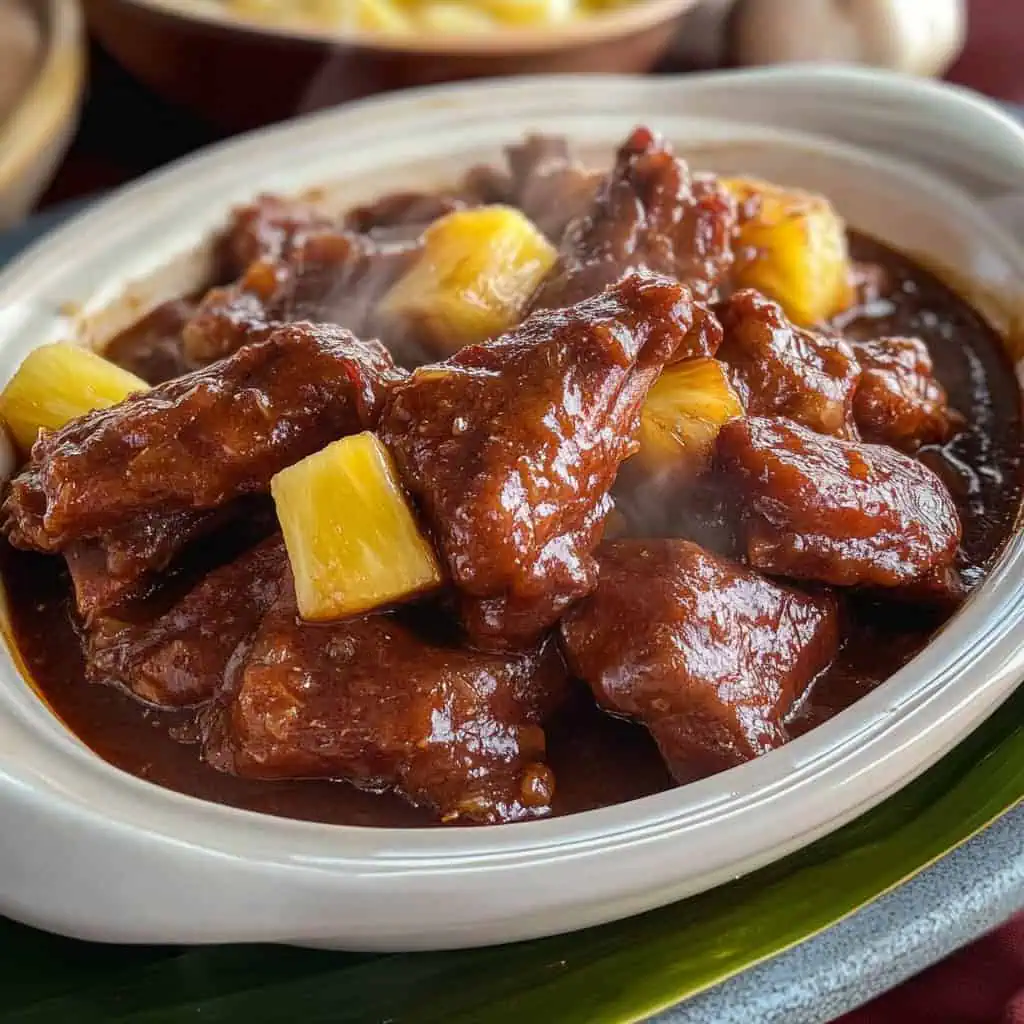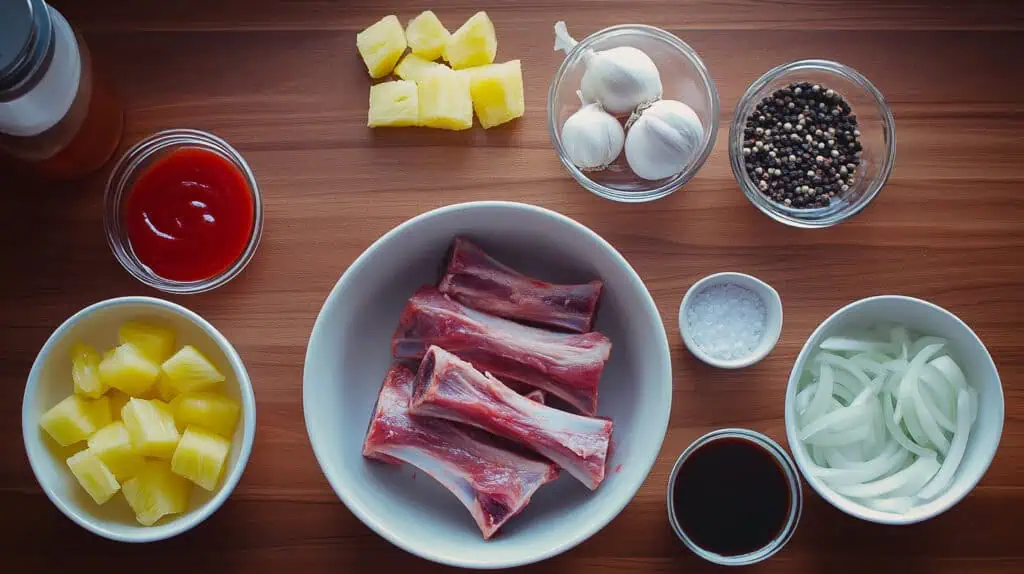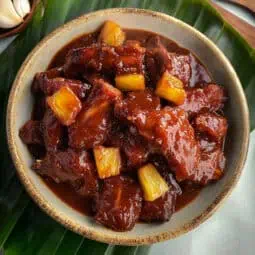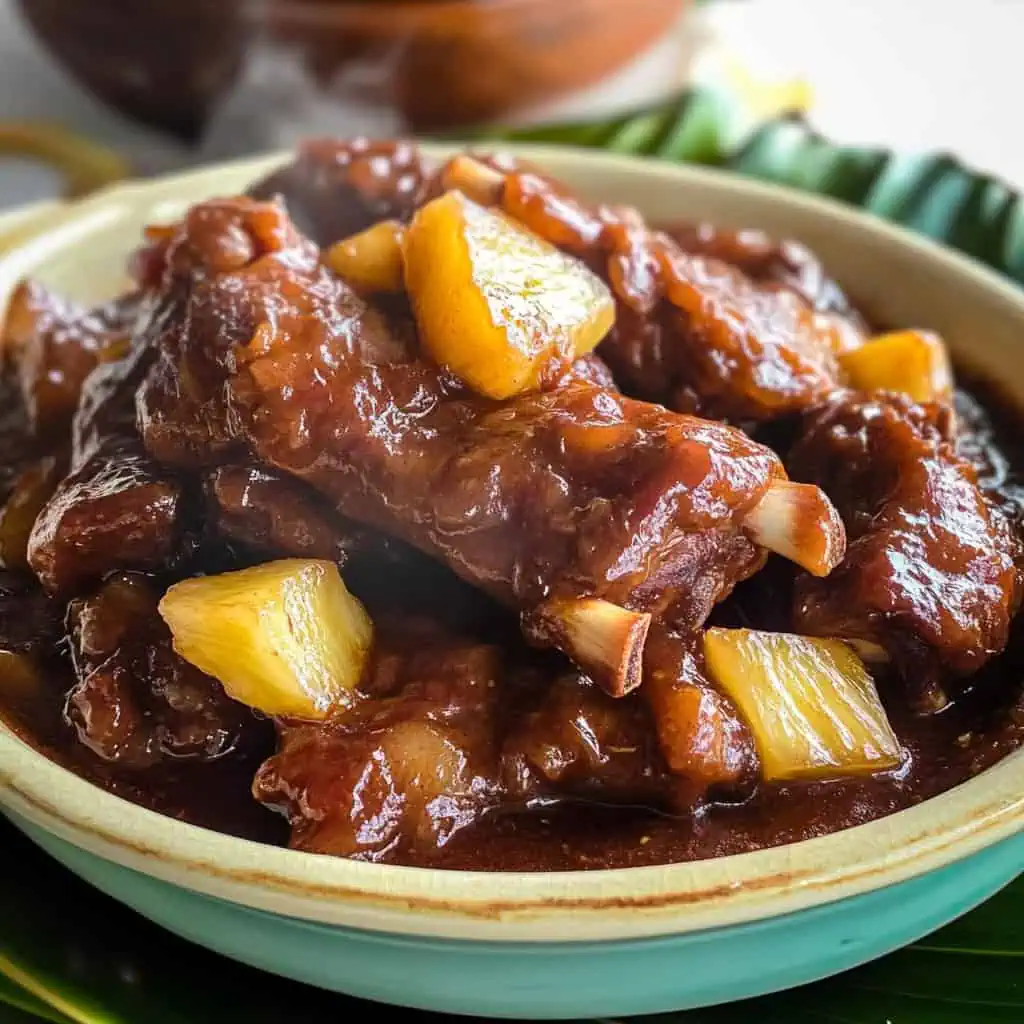These braised spare ribs with ketchup and pineapple are my secret weapon for those days when I want maximum flavor with minimal effort. It's the kind of dish where you just throw everything in the pot and let it do its thing while you catch up on your favorite Netflix show.
I discovered this recipe during my college days when I was missing my mom's home cooking but didn't have her level of kitchen expertise. You can't really mess it up. The banana ketchup (yes, that Filipino kitchen staple) and pineapple do all the heavy lifting in the flavor department. Plus, it's basically a one-pot wonder – just sear, pour, and let it simmer away until the meat is falling off the bone.
What Is Filipino-Style Braised Spare Ribs?
Braised Spare Ribs with Ketchup and Pineapple is a Filipino comfort dish where tender pork spare ribs are marinated and slow-cooked in a sweet-tangy sauce combining banana ketchup, pineapple juice, and soy sauce. The meat becomes fork-tender while absorbing the fruity, savory flavors of the sauce, enhanced by aromatics like ginger, garlic, and onions. The addition of pineapple chunks brings brightness and textural contrast to this hearty, family-style dish that perfectly exemplifies Filipino cuisine's harmonious blend of sweet and savory elements.
Jump to:

Why You'll Love This Recipe
- Fork-tender meat that falls off the bone
- Perfect balance of sweet, tangy, and savory flavors
- Simple ingredients you can find in any Asian grocery store
- Make-ahead friendly for busy weeknights
- Great for both family dinners and special occasions
- Budget-friendly yet impressive dish
Ingredients
Each ingredient in this recipe serves a specific purpose. Pork spare ribs offer the perfect balance of meat and fat for rich flavor and tender texture. Pineapple provides natural enzymes that tenderize the meat while adding sweetness.
Banana ketchup brings a uniquely Filipino sweet-tangy profile that regular ketchup can't match. Fresh ginger, garlic, and onion create an aromatic base, while soy sauce adds depth and umami.
Together, these ingredients create a perfect harmony of sweet, savory, and tangy flavors that's greater than the sum of its parts.

- 2 pounds pork spare ribs, cut into 2-inch cubes
- 1 can (20 ounces) pineapple chunks, drained (reserve juice)
- 1 thumb-size fresh ginger
- 1 medium onion, chopped
- 2 cloves garlic, minced
- 1 cup pineapple juice (from canned pineapples)
- ¼ cup light soy sauce
- ½ cup banana ketchup
- Salt and pepper to taste
- 1 tablespoon cooking oil
- 1 cup water
Equipment
- Large Heavy-Bottom Pot - For even heat distribution and proper braising
- Sharp Knife - For cutting ribs into portions
- Cutting Board - For meat preparation and chopping ingredients
- Grater - For grating fresh ginger
- Measuring Cups and Spoons - For precise ingredient amounts
- Tongs - For turning meat while browning
- Garlic Press (optional) - For mincing garlic effortlessly
- Strainer - For extracting ginger juice
- Mixing Bowl - For marinating the meat

How To Make
- Season and Marinate: In a large bowl, season the pork spare ribs with salt and black pepper until evenly coated. Extract juice from grated ginger by squeezing it through a strainer and set aside. Combine pineapple juice, soy sauce, banana ketchup, and the ginger juice in a bowl. Add the seasoned spare ribs to this marinade and gently massage the liquid into the meat. Place in the refrigerator for 30 minutes.
- Sear the Meat: Remove the meat from the marinade and drain well, saving the marinade for later. Heat oil in a deep pot over medium heat. Cook chopped onions and minced garlic until the onions become soft and translucent, about 3-4 minutes. Add the marinated spare ribs and cook, turning occasionally, until the meat browns lightly on all sides, about 8-10 minutes.
- Braise: Pour in the saved marinade and water, then bring everything to a boil. Once boiling, lower the heat, cover the pot, and let it simmer gently for 40-50 minutes. Stir occasionally to prevent sticking. The meat is ready when it's tender enough to easily pull apart with a fork.
- Finish the Dish: When the meat is tender and the sauce has thickened slightly, add the pineapple chunks. Cook for 2-3 minutes more until the pineapples are heated through. Taste the sauce and add more salt or pepper if needed. Turn off the heat and let everything rest for 5 minutes before serving.
- Serve: For best results, serve hot over steamed white rice. The sauce should be thick enough to coat the back of a spoon, and the meat should easily separate from the bone.

Tips from Lola's Kitchen
- Choose ribs carefully: Look for ribs with a good meat-to-fat ratio for the best flavor and texture
- Ginger technique: Grate ginger against the fiber for maximum juice extraction
- Don't rush the browning: This crucial step develops deep flavor foundation for the dish
- Patience pays off: Slow, gentle simmering yields the most tender results
- Thicken naturally: If sauce is too thin, remove lid during final 10-15 minutes of cooking
- Rest before serving: Let meat rest 5-10 minutes before serving for juicier results
- Taste as you go: Adjust seasonings gradually, especially when adding salt or soy sauce
Substitutions
- Banana Ketchup: Regular tomato ketchup mixed with 1 tablespoon brown sugar and a pinch of allspice
- Spare Ribs: Pork belly, pork shoulder, or country-style ribs work well as alternatives
- Fresh Pineapple: Can substitute canned pineapple tidbits or rings (ensure they're in juice, not syrup)
- Fresh Ginger: 1 teaspoon ground ginger mixed with a splash of lemon juice in a pinch
- Soy Sauce: Liquid aminos or coconut aminos for a gluten-free option
- Water: Chicken broth for extra flavor depth
Troubleshooting
- Sauce too thin: Continue cooking uncovered for 5-10 minutes to reduce the liquid. Alternatively, create a slurry by mixing 1 tablespoon cornstarch with 2 tablespoons cold water and stirring it into the simmering sauce.
- Meat is tough: Your cooking temperature may be too high. Lower the heat and extend cooking time by 15-20 minutes, adding small amounts of water if needed. Pork should be tender enough that it easily separates with a fork.
- Sauce too sweet: Balance the sweetness by adding 1 tablespoon of cider vinegar or an extra splash of soy sauce to taste.
- Sauce too salty: Add a peeled, quartered potato to absorb excess salt, or stir in additional pineapple chunks with their juice.
- Burning on bottom: Lower heat immediately and transfer to a different pot if necessary. Don't scrape the burnt bits into the sauce.
Storage & Reheating
- Refrigeration: Store in an airtight container for up to 3 days. Allow to cool completely before refrigerating.
- Freezing: Transfer cooled portions to freezer-safe containers or bags, removing as much air as possible. Freeze for up to 3 months.
- Reheating from refrigerated: Place in a pan over medium-low heat, adding 2-3 tablespoons of water to prevent drying. Heat until internal temperature reaches 165°F (74°C).
- Reheating from frozen: Thaw overnight in refrigerator before reheating using the method above.
- Flavor development: This dish often tastes even better the next day as flavors meld together.

FAQ
Can I use fresh pineapple instead of canned?
Yes, but reduce marinating time to 15 minutes as fresh pineapple's enzymes are stronger and may over-tenderize the meat if left too long.
Can I cook this in a slow cooker?
Absolutely! Brown the meat and aromatics first, then cook on low for 6-8 hours or high for 4-6 hours. Add the pineapple chunks during the last 30 minutes.
Is this recipe freezer-friendly?
Yes, it freezes well for up to 3 months in an airtight container. The flavors may even develop further during freezing.
Can I make this dish ahead for a party?
This dish is perfect for make-ahead meals. In fact, it often tastes better the next day as flavors develop further. Reheat gently before serving.
How do I know when the meat is done?
The meat should easily separate from the bone and be fork-tender. If you encounter resistance when piercing with a fork, continue cooking.
What's the best cut of spare ribs to use?
St. Louis-style ribs work best for this recipe, but baby back ribs can also be used (reduce cooking time by about 10 minutes).
Can I add vegetables to make it a complete meal?
Absolutely! Bell peppers, carrots, or potatoes make excellent additions. Add firmer vegetables like carrots and potatoes with the braising liquid, and softer vegetables like bell peppers during the last 15 minutes.
Can I reduce the sugar content?
Yes, you can use less banana ketchup or substitute with a lower-sugar alternative. The dish will be less sweet but still flavorful.
Related
Looking for other recipes like this? Try these:

Filipino-Style Braised Spare Ribs with Ketchup and Pineapple
Equipment
- Large Heavy-Bottom Pot (Kaldero) For even heat distribution and braising
- Sharp knife (kutsilyo) For cutting ribs into portions
- Cutting board (Sangkalan) For meat preparation
- Grater (kudkuran) For grating fresh ginger
- Measuring cups and spoons (Panukat) For precise ingredients
- Tongs [Sipit] For turning meat while browning
- Garlic press (optional) For mincing garlic
Ingredients
Main Ingredients:
- 2 pounds pork spare ribs Liempo, cut into 2-inch cubes
- 1 can 20 ounces pineapple chunks (Pinya), drained (reserve juice)
- 1 thumb-size fresh ginger Luya
- 1 medium onion Sibuyas
- 2 cloves garlic Bawang
Sauce and Seasonings:
- 1 cup pineapple juice from canned pineapples
- ¼ cup light soy sauce Toyo
- ½ cup banana ketchup Ketsup na Saging
- Salt Asin and pepper (Paminta) to taste
- 1 tablespoon cooking oil Mantika
- 1 cup water Tubig
Instructions
- In a large bowl, season the fresh pork spare ribs with salt and black pepper until evenly coated. Extract juice from grated ginger by squeezing it through a strainer and set aside. Combine pineapple juice from the canned pineapples, soy sauce, banana ketchup, and the ginger juice in a bowl. Add the seasoned spare ribs to this marinade and gently massage the liquid into the meat. Place in the refrigerator for 30 minutes.
- Remove the meat from the marinade and drain well, saving the marinade for later. Heat oil in a deep pot over medium heat. Cook chopped onions and minced garlic until the onions become soft and clear, about 3-4 minutes. Add the marinated spare ribs and cook, turning occasionally, until the meat browns lightly on all sides, about 8-10 minutes.
- Pour in the saved marinade and water, then bring everything to a boil. Once boiling, lower the heat, cover the pot, and let it simmer gently for 40-50 minutes. Stir occasionally to prevent sticking. You'll know the meat is ready when it's tender enough to easily pull apart with a fork.
- When the meat is tender and the sauce has thickened slightly, add the pineapple chunks. Cook for 2-3 minutes more until the pineapples are heated through. Taste the sauce and add more salt or pepper if needed. Turn off the heat and let everything rest for 5 minutes before serving.
- For best results, serve hot over steamed white rice. The sauce should be thick enough to coat the back of a spoon, and the meat should easily separate from the bone. Any leftovers can be stored in an airtight container in the refrigerator for up to 3 days.
Tips from Lola's Kitchen
- Choose ribs with a good meat-to-fat ratio for the best flavor
- Grate ginger against the fiber for maximum juice extraction
- Don't skip the browning step – it develops deep flavor
- If sauce is too thin, remove lid during final cooking
- Let meat rest 5-10 minutes before serving for juicier results
Nutrition
The Story Behind Filipino-Style Braised Spare Ribs with Ketchup and Pineapple
Some of our most beloved recipes weren't born in traditional kitchens but emerged from the creative spirit of post-war Filipino cooks. This braised spare ribs with banana ketchup and pineapple is one such culinary innovation, showcasing the unique Filipino talent for transforming American military surplus ingredients into something extraordinarily delicious.
The star of this dish, banana ketchup, tells its own fascinating story. During World War II, when tomato ketchup became scarce in the Philippines, food technologist Maria Y. Orosa invented banana ketchup as a practical alternative. This bright red, banana-based condiment quickly became a Filipino pantry staple, leading to creative recipes like these spare ribs that perfectly balance sweet, savory, and tangy flavors.
The addition of pineapple to meat dishes is another beloved Filipino cooking tradition, seen in favorites like hamonado and pineapple chicken. This combination wasn't just about flavor – pineapple's natural enzymes help tenderize meat, making tougher cuts like spare ribs wonderfully tender. It's a technique that became especially popular in the 1960s when canned pineapples became readily available in local markets.
Today, this dish represents the heart of Filipino home cooking – practical, adaptable, and full of flavor. Whether you're using premium spare ribs or more budget-friendly cuts, the combination of banana ketchup and pineapple transforms the meat into something special. It's the kind of recipe that embodies the Filipino concept of "gimikan" or resourcefulness in the kitchen, where simple ingredients come together to create something greater than the sum of their parts.
What makes this recipe particularly special is how it's evolved in Filipino-American households. Many Filipino-American families have adapted it to include both banana ketchup and tomato ketchup, creating a unique fusion that pays homage to both cultures. It's become a potluck favorite, often served alongside traditional American barbecue dishes, bridging culinary traditions and creating new ones in the process.










Comments
No Comments